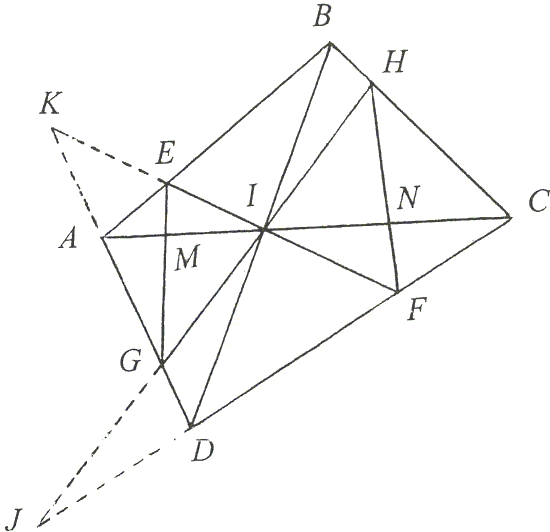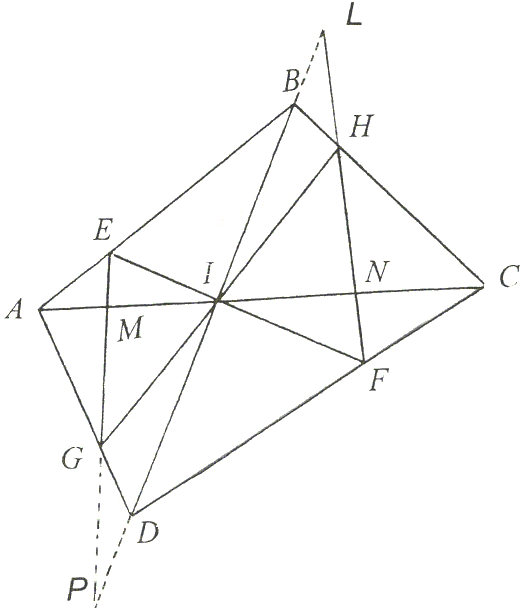The Lepidoptera of the Quadrilateral II
Sidney Kung
April 26, 2008
We prove the Butterfly Theorem with the aid of Menelaus' theorem.
Through the intersection I of the diagonals AC, BD of a convex quadrilateral ABCD, draw two lines EF and HG that meet the sides of ABCD in E, F, G, H. Let M and N be the intersections of EG and FH with AC. Then
1/IM - 1/IA = 1/IN - 1/IC.
Proof
 | |
| Figure 1. |
Refer to Figure 1. Triangles BAD and CAD are cut by transversal EIF. So, by applying Menelaus' theorem twice, we have
BE/EA · AK/KD · DI/IB = 1,
CF/FD · DK/KA · AI/IC = 1.
Multiplying the above gives
BE/EA · ID/IB · CF/FD · IA/IC = 1,
or
| (1) | IA · ID · BE/EA = IC · IB · FD/CF. |
Similarly, since transversal HIG cuts triangles BDC and ADC, applying Menelaus' theorem twice again will give us
AG/GD · DI/IB · BH/HC · CI/IA = 1,
or
| (2) | ID · IC · BH/HC = IB · IA · DG/GA. |
Note that neither (1) nor (2) involves IM, MA, IN, or NC. The relationship among these and other line segments in the figure will be established as follows:
 | |
| Figure 2. |
Refer to Figure 2. Let L and P be the intersections of FH and EG with BG. Consider the triangle CDI with transversal FH, we have
DF/ FC · CN/NI · IL/LD =1,
or
| (3) | DF/FC = IN/NC · LD/IL. |
Similarly, from triangle CIB, we see that
BH/HC · CN/NI · IL/LB = 1,
or
| (4) | BH/HC = NI/CN · LB/IL. |
Thus,
| (5) |
|
Again, we apply the Menelaus theorem on triangles AIB and ADI to get
| (6) | BE/EA = MI / AM · PB/IP |
and
| (7) | DG / GA = MI / AM · PD/IP, |
respectively. So,
| (8) |
|
Now, multiplying (5) by IC, we get
| (9) | IC · IB · DF/FC + IC · ID · BH/HC = IC · BD · IN/NC |
and multiply (8) by IA, we have
| (10) | IA · IB · DG/GA + IA · ID · BE/EA = IA · BD · IM/MA. |
Finally, by subtracting (10) from (9), and taking into account (1) and (2), we obtain
BD · ((IC · IN)/NC - (IA · IM)/MA ) = 0.
It follows then that
(IA - IM)/(IA · IM) = (IC - IN) / (IC · IN).
Therefore, 1/IM - 1/IA = 1/IN - 1/IC, as required
Butterfly Theorem and Variants
- Butterfly theorem
- 2N-Wing Butterfly Theorem
- Better Butterfly Theorem
- Butterflies in Ellipse
- Butterflies in Hyperbola
- Butterflies in Quadrilaterals and Elsewhere
- Pinning Butterfly on Radical Axes
- Shearing Butterflies in Quadrilaterals
- The Plain Butterfly Theorem
- Two Butterflies Theorem
- Two Butterflies Theorem II
- Two Butterflies Theorem III
- Algebraic proof of the theorem of butterflies in quadrilaterals
- William Wallace's Proof of the Butterfly Theorem
- Butterfly theorem, a Projective Proof
- Areal Butterflies
- Butterflies in Similar Co-axial Conics
- Butterfly Trigonometry
- Butterfly in Kite
- Butterfly with Menelaus
- William Wallace's 1803 Statement of the Butterfly Theorem
- Butterfly in Inscriptible Quadrilateral
- Camouflaged Butterfly
- General Butterfly in Pictures
- Butterfly via Ceva
- Butterfly via the Scale Factor of the Wings
- Butterfly by Midline
- Stathis Koutras' Butterfly
- The Lepidoptera of the Circles
- The Lepidoptera of the Quadrilateral
- The Lepidoptera of the Quadrilateral II
- The Lepidoptera of the Triangle
- Two Butterflies Theorem as a Porism of Cyclic Quadrilaterals
- Two Butterfly Theorems by Sidney Kung
- Butterfly in Complex Numbers
|Contact| |Front page| |Contents| |Geometry|
Copyright © 1996-2018 Alexander Bogomolny
73599996
